Some straight talk from new sheriff
January 29, 2014
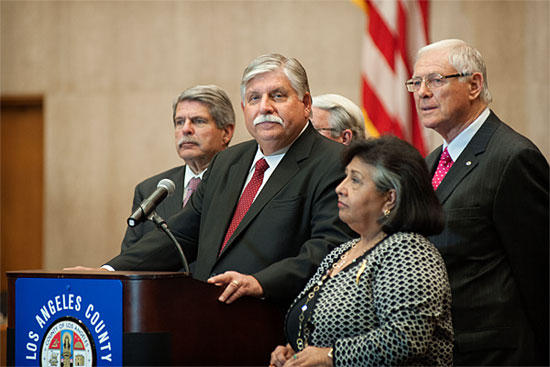
Interim Los Angeles County Sheriff John Scott (center) is flanked by supervisors as he meets the press.
After 36 years on the Los Angeles County Sheriff’s Department—with jobs ranging from street patrol in Lakewood to overseeing the country’s largest jail system—John Scott did not like what he was seeing.
“I thought the direction of the department was taking a turn that I did not want to be part of,” Scott recalled. “I saw diminished accountability. I saw fragmentation within the department. I saw some people who did not represent the best interests of the department.”
Scott said he felt “an obligation to talk to the sheriff.” But after voicing his concerns, he said he did not believe he had the support he needed “to fight the good fight.” So in March of 2005, he retired.
But on Tuesday afternoon, nearly nine years later, he was back, standing before a bank of TV cameras in the downtown Hall of Administration. He was flanked by members of the Board of Supervisors, who had just selected him as the department’s interim sheriff. His mandate: to keep the troubled agency moving swiftly toward reform until the election of a new sheriff either in the June primary or November runoff.
Scott will replace Sheriff Lee Baca, who officially retires on Thursday at noon. Baca’s departure comes after more than two years of steady controversy that eroded the agency’s reputation, including the recent indictments of 18 current and former members of the department for alleged brutality in the jails and obstruction of justice.
With no incumbent on the ballot, the race to succeed Baca has turned into one of the most heavily contested in the department’s recent history. At the same time, Baca’s unexpected retirement put enormous pressure on the Board of Supervisors to find an interim sheriff who would aggressivelyimplement reforms recommended in 2012 by the blue-ribbon Citizen’s Commission on Jail Violence. “We didn’t want a caretaker,” said Supervisor Zev Yaroslavsky. “And we didn’t want someone distracted by campaigning for the job.”
Scott seemed to be a good fit on both counts.
Besides his years of service in Los Angeles, Scott has spent the past 5 years as the undersheriff in Orange County. There, he has helped the agency recover from a sensational corruption scandal involving ex-Sheriff Michael Carona, who ended up in federal prison for witness tampering. Scott was recruited by Carona’s successor, Sandra Hutchens, a former division chief in the Los Angeles County Sheriff’s Department. (Scott, who is taking a leave of absence from his Orange County post, will return there after Baca’s replacement is sworn in.)
In an interview Wednesday with a writer for Supervisor Yaroslavsky’s website, Scott said his first—and top—priority will be to make sure everyone on the command staff is “in alignment” with the mission of bringing substantive reform and accountability to the department so they can effectively communicate it throughout the organization.
“I need to know that I have their complete buy-in,” he said. “If I don’t, then there’s going to be changes. I’m not bashful about that.”
Scott said he’s optimistic that changes in policy and direction can come quickly. But he said he’s realistic about the deeper cultural changes. “That’s a time-tested kind of process,” he said. “It’s like turning that big aircraft carrier.”
In Orange County, he said, some members of the department who resisted change ended up leaving the department because “it was heading down a different path—not one they chose. What you’re left with are people who have bought in.” He said he suspects the same thing could happen in Los Angeles.
For help in his new job, Scott has turned to a former colleague, retired Field Operations Chief Neal Tyler, who’ll return as an executive officer.
“I need immediate assistance from someone I know and trust,” Scott said of Tyler, who oversaw operations in Malibu/Lost Hills, Crescenta Valley, Altadena and Lancaster, among other places. Scott said that Tyler, like him, “had a great deal of difficulty with things that were going on.” Tyler left the department about a year ago, Scott said.
Scott said one of the challenges they’ll face is keeping the political race for sheriff from creating divisions and distractions in the rank and file. The current field includes two high-ranking insiders, as well as two former members of the department who’ve maintained alliances on the force. He said he will make it clear to the two inside candidates that “the operation of the Sheriff’s Department is Priority One and that their campaigns are on their own time…The mission is what we need to focus on, not the candidates. We need to keep this ship righted.”
On a personal level, Scott said his wife, Alice, strongly supports his return to the department so he can finally press ahead with the reforms he wanted to initiate before he felt compelled to leave. She’s a former sheriff’s captain, who retired in 2010, and, like him, did not like what she saw.
“She is one of those who watched internally and then from a distance and felt very disappointed and frustrated,” Scott said, adding: “I want to bring back the department’s premiere status.”
Posted 1/30/14
Bringing the family together
September 12, 2013
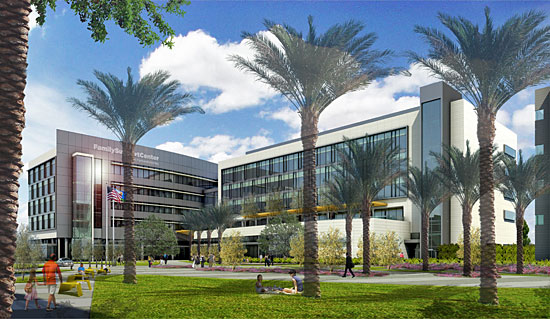
A rendering of the San Fernando Valley Family Support center, which will provide a new, collaborative model for bringing government to the people.
Problems don’t always come one at a time.
When families need help for more than one reason, they often have to visit various locations and wait in lines while navigating the bureaucracies of multiple government agencies. But an innovative project in the San Fernando Valley will streamline that process by cutting the red tape in a new, state-of-the-art facility.
The San Fernando Valley Family Support Center, which breaks ground in Van Nuys on Saturday, Sept. 21, will bring seven Los Angeles County departments under one roof—in a building specially-designed to foster collaboration. Michael Samsing, who has worked on the project for the county Chief Executive Office since 1999, said the center will bring government to the people in a new way.
“It’s a one-stop location where families can access all the services that can help them,” Samsing said. Whether it’s food assistance, parenting skills or a child on probation, he said, “we’re going to get all the departments working together for the one client that comes to get services.”
This is the first time this kind of team effort has been planned from the ground up, Samsing said. Previously, departments have been co-located in a single building but didn’t fully integrate their operations, remaining separated by walls and layers of bureaucracy.
Samsing saw some of those barriers fall at meetings during which departments provided input on the project. “It was interesting to hear departments realize that they have common clients, that there are other services we can provide,” he said. “We all work in silos and this is really meant to blow that up.”
It all starts with the building—a five-story structure designed by HKS Architects, Inc. Thom Greving, the project designer, said the job reached the heart of what it means to be an architect. “People think we design buildings, but that’s secondary to what architecture really is—to craft experiences,” he said.
The design employs fewer walls and plenty of common areas, along with shared meeting rooms and group workstations in an open, campus-like environment. To create an uplifting work environment, Greving included a healthy dose of sunlight; 90% of employees will be within 30 feet of a window. The campus features walking paths, bike racks and plenty of greenery, including 380 new trees and a large, live oak as the centerpiece for the courtyard. Clients will enter a shared lobby, where they’ll check in through kiosks or greeters, Greving said.
The complex will be built on county-owned property on Van Nuys Boulevard, in an area that was found to have the highest concentration of social service cases in the valley, according to a study commissioned by the CEO in 2000. Two empty county facilities and a vacant bowling alley have been razed to make way for the new project. (The Mid-Valley Comprehensive Health Center, also located on the property, will continue to operate throughout construction and afterwards.)
The new building is targeted to achieve LEED Gold certification for environmental sustainability, but Greving said it might even make LEED Platinum, a much rarer distinction. Efficient heating and cooling systems will be installed in floors and bio-filtration gardens will serve as retention ponds to clean storm water runoff.
Each of the departments that will be housed there—Children and Family Services, Public Social Services, Child Support Services, Probation, Health Services, Mental Health and Public Health—will pay part of the $175.9 million price tag. Supervisor Zev Yaroslavsky, who has been involved in planning since the beginning, has also allocated $9.6 million to the project.
The support center also could provide much-needed economic revitalization in the area, said David Howard, who is managing its construction for the Department of Public Works. “With all the county employees and visitors,” he said, “there will be a lot of people seeking restaurants and shops.”
With construction underway, Samsing and another county CEO employee, Carlos Pineda, will focus on the operational details. Pineda is optimistic about the new environment, but he acknowledged that challenges remain. Technological incompatibilities, legal issues and requirements on how funds can be spent are all hurdles to confront. Pineda and Samsing hope their work will become a blueprint for future service, a more efficient model that will help families become aware of the full spectrum of assistance that county government can provide.
“Up until now we have been focused on the space,” Pineda said. “Now we’re figuring out how it will all work together.”
Posted 9/12/13
A greener future opens up
September 12, 2013
For decades, it has been just another big, concrete L.A. channel, a place known mainly for the unfortunate passersby who have had to be rescued there during winter rains.
But the hardworking Pacoima Wash has been getting a makeover lately, and this week, the Board of Supervisors approved the finishing touches for a 4.75-acre park that will give yet another neighborhood along the tributaries and banks of the Los Angeles River a welcome sliver of green.
“I think it’s going to be good,” said Bertha Macias, a stay-at-home mom in San Fernando on Tuesday as her 4 year old, Benjamin, ran back and forth between the fence and the walkway of her tiny front yard a block from the soon-to-be-opened Pacoima Wash Eighth Street Park.
A mother of three, Macias said her dense neighborhood has far too little open space for the number of children who live there. “I think it will be good for the kids to go to in the afternoons after school,” she said in Spanish. “They’ll watch less television if they can go to a park.”
Due to open in early 2014, the park, which runs between Eighth Street and Foothill Boulevard in the City of San Fernando, marks yet another bit of progress, both for its community and for the long-term movement to re-green the Los Angeles River and its various branches in L.A..
Constructed in the 1940s as a 10-mile-long flood control channel, the Pacoima Wash is a tributary of the Tujunga Wash, which in turn is a tributary of the Los Angeles River. When it rains, its industry-lined banks typically fill with trash and polluted runoff.
Historically, it has been viewed as a purely utilitarian conduit for inland water, and it has been fenced off from the dense, park-starved communities that abut it, dividing them like a freeway. But in 2005, the Mountains Recreation and Conservation Authority acquired several parcels of land along the channel. And in 2008, with the help of a Los Angeles County Department of Public Health grant, a coalition led by the grassroots environmental nonprofit Pacoima Beautiful launched an initiative to reimagine the wash as a place that might not only do a better job of filtering storm water, but also double as an urban greenbelt.
“These communities are, in a lot of ways, park-poor and in need of nature and green space,” said Ana Petrlic, deputy chief of urban projects and watershed planning for MRCA. “And bringing nature to the city is a primary goal of MRCA.”
Indeed, according to Pacoima Beautiful, the community of Pacoima alone has only about a quarter of the park space it should have under the City of Los Angeles’ general plan standards. Meanwhile, one in four residents suffers from heart disease and 29% of the young people are obese.
The MRCA acreage has been combined with land owned by the Los Angeles County Flood Control District to create the first of what MRCA envisions as a series of parks along the wash. Nearly complete, the Pacoima Wash Eighth Street Park, designed by the Los Angeles environmental design firm Blue Green, will feature a small loop trail, a pair of quaint bridges, an arbor for shade and some picnic tables and benches.
“There are great views of the mountains and the Angeles National Forest,” said Petrlic, “and native plants for habitat for the local wildlife.” Built into the park’s design is a system to detain and treat storm water runoff, which will enter the site underneath two small circular plazas—one at Eighth Street, the other at Bromont Avenue—that are equipped with underground filters to catch trash. From there, the water will flow into a newly constructed creek bed that runs parallel to the wash, where it will be further cleansed of pollutants.
“And,” Petrlic said, “that’s all before the water actually reaches the wash.”
This week, the Los Angeles County Supervisors voted to take the greening effort up a notch. They approved a $100,000 grant from Third District park funds to add about 150 new trees to make the now spare-looking space a bit more inviting.
“This is a good thing,” said Manuel Franco of Pacoima, an MRCA worker, as he checked sprinkler heads Tuesday along the greenbelt. “Good for this area. Good for families.”
Posted 9/12/13
A new river runs through it
July 25, 2013
For most longtime Angelenos, the Los Angeles River has represented little more than a concrete scar across the county, a channel sending urban runoff and debris towards the sea. Although largely justified in the past, that perception has failed to keep pace with the river’s emerging new realities and its potential to become one of the grandest urban greenways in America.
There was a time when the Los Angeles River was a lifeline for our region. Along its banks, the Gabrielino Indians hunted, fished and lived. The Spanish established the city’s earliest settlements on the river, which would later power the area’s industrial growth. But by the early 20th Century, the river simply could no longer co-exist with the Los Angeles Basin’s explosive growth. A deadly flood in the winter of 1938 finally led to its encasement in concrete, paving the way for the river to become more famous as a backdrop for movie car chases than for its real-life story.
To be sure, long stretches of the river’s 51-miles remain as barren today as they did a quarter-century ago. But elsewhere, a rebirth has been taking root like the lush foliage that again blankets the riverbed between downtown L.A. and Griffith Park. In fact, through a burgeoning public-private partnership, a reimagining of the river’s place in modern-day Los Angeles is gaining unprecedented traction.
President Obama recently made the rejuvenation of the L.A. River a top priority in his urban waterways initiative. And with the federal government’s earlier recognition that the river should be open for recreational use, higher water quality standards are also on the way.
The City of Los Angeles, along with the county and other municipalities, has built miles of new bikeways along the river. In April, NBCUniversal committed nearly $14 million toward the completion of a 6.4 mile gap between Griffith Park and Studio City. Pocket parks also are sprouting on the river’s banks. A summer pilot program has people from across the region kayaking and fishing in its Glendale Narrows passage. And this week, we celebrated the public and private support that will soon give rise to La Kretz Crossing—a stunning pedestrian, equestrian and cyclist bridge near Atwater Village.
But all this is only a start in turning the river into a truly vibrant public space, where our diverse population can not only share recreational opportunities but also forge a broader sense of community from the valley to the ocean. In one of the nation’s most densely developed regions, the Los Angeles River represents a unique opportunity to transform blighted infrastructure into a scenic refuge—a quintessentially L.A. version of New York’s hugely popular “High Line,” a mile-long aerial park built along old railroad tracks.
That’s the charge of Greenway 2020, an initiative spearheaded by the non-profit Los Angeles River Revitalization Corporation, which has an immediate goal of completing all 51 miles of the river bikeway by the end of this decade. Filling in gaps totaling 24 miles through government and private financing, the path would extend from the west San Fernando Valley to Long Beach, complete with amenities such as bike shops, eateries and picnic sites.
Daily commuters would be able to ditch crowded roads and buses in favor of a beautiful—and healthy—bike to work. The 100,000-plus cyclists who’ve turned out for the street-closing CicLAvia events is proof of the pent-up demand for bicycle experiences that don’t compete with automobiles. Entire families, meanwhile, would have a desperately needed getaway in our concrete landscape to play, to breathe and to build memories.
Every world-class city has public spaces that define it. But these monuments to urban life don’t build themselves. Communities come together to create them, and such will be the case for Greenway 2020. It will require coordination and commitment among L.A.’s community leaders, its governmental agencies and its private sector, including business and property owners along the river.
Most of all, it will require a grassroots movement to prove that Los Angeles is ready to make this vision a reality. We urge you to get involved – sign up at larivercorp.com to join Greenway 2020’s effortsand learn more about the project. Attend community meetings. Convey your support to your elected officials. Participate in L.A. River cleanups. Bike and kayak with your friends.
And help us chart a course for the river that will, once again, let it nourish life across Los Angeles.
This piece was co-authored by Allan J. Abshez, board member of the Los Angeles River Revitilizaton Corp.
Posted 7/25/13
Storming the beach as runoff flows
December 6, 2012
The first storm of a Southern California winter can be welcome and even romantic. Not so the aftermath—or as clean-up crews at the beach wryly call it, “The First Flush.”
“Those big storms really clean out the creeks and the catch basins,” says Carlos Zimmerman, assistant chief in the facilities and property maintenance division at the county Department of Beaches & Harbors, and a 33-year employee of the department. “Everything washes down—trees, bushes, firewood, plastic bottles, foam containers. Tons and tons of trash. Dead dogs and cats. Snakes. All kinds of things, you wouldn’t believe it. I saw a BMW come out of Topanga Creek once.”
That’s why, as rainstorms pelted Southern California last weekend, county and municipal crews were hitting the beaches to clean up debris. Their efforts are just one of the ways—from pending litigation to an upcoming Clean Water, Clean Beaches ballot measure—in which runoff will be front and center this winter in Los Angeles County
“Things like education efforts and ordinances against single-use plastic bags and polystyrene containers are making inroads, but it’s obviously an extreme problem,” notes Kirsten James, water quality director at Heal the Bay, the environmental advocacy organization.
Debris, she notes, is just the most visible pollution that courses into the ocean after a rainstorm. (This is one reason why health officials recommend staying out of the ocean for 72 hours after a rainstorm.)
“Heavy metals and bacteria are in there as well,” James says. “Some years, [the First Flush] looks like you’re not even in a First World country—more like you’re at a dump than at the beach.”
Kerry Silverstrom, chief deputy director at Beaches & Harbors, says that county beaches get runoff from more than 200 storm drains, as well as from Ballona Creek, which dumps runoff from miles inland into Santa Monica Bay. Though “trash catchers” installed throughout the system in recent years are intercepting more and more garbage, some still is making it down to the shoreline. Because storm water often continues to flow long after a heavy rainfall, and the debris it carries can churn on the waves for days before being washed up by high tide, the cleanup after a storm usually lasts long after the clouds part.
“That was one of the surprises when I first came to Beaches & Harbors,” says Silverstrom. “I had no idea that there was as much winter work on the beaches as summer work.”
That winter work, done by year-round maintenance crews, can mean anything from tending beach restrooms to piling sandbags to pulling lifeguard towers back from the pounding surf. Kenneth Foreman, chief of the department’s facilities and property maintenance division, says nearly 80 county workers were deployed at a dozen coastal beaches after last weekend’s rain storms, from equipment operators with sand-sanitizing machinery to hand crews who walked the high-tide line, plucking scraps of litter.
The winter crews, he adds, start at 6 a.m. and work every day, rain or shine, including weekends. “We worked Saturday and Sunday, even though it was storming,” he says. “Often by the time the general public hits the beach, they have no idea how dirty it was before they got there.”
There are things the public can do to help limit beach pollution, from proper disposal of motor oil and animal waste to keeping trash out of the storm drains to letting local stormwater coordinators know if flooding occurs in your neighborhood from trash-clogged catch basins.
On a longer-term level, the Board of Supervisors will conduct a January 15 public hearing on whether to seek property owner approval of the Clean Water, Clean Beaches measure through a mail-in ballot. The measure, prompted in part by toughened federal clean water standards, would raise $270 million for stormwater projects in Los Angeles County by assessing parcel owners based on the amount of runoff they generate (about $54 a year for a typical single-family residence.)
Meanwhile, cleanup crews will be fighting the good fight on a landscape that, when the storms hit, still too often becomes long on odor and short on scenery. At a Santa Monica city beach near the Pico/Kenter storm drain, a Heal the Bay staffer blogged last Friday morning that the sight and stench were “shocking.”
“I . . . saw runoff flowing fast out onto the Santa Monica beach, carrying along with it strong smells reminiscent of motor oil and gasoline, hundreds of plastic cups, chip bags, soda cans, an unusually high number of tennis balls, plastic bags (some full of pet waste), bits of Styrofoam, bottle caps, and more urban detritus,” blogged interactive campaigns manager Ana Luisa Ahern, who posted some haunting pre-cleanup photos on the organization’s web site.
“It was a saddening and somber sight, to say the least.”
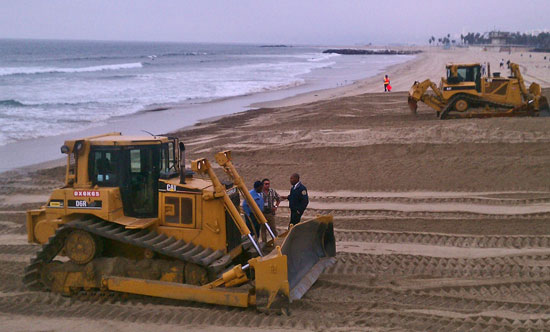
Kenneth Foreman Sr. of Beaches & Harbors, in jacket at far right, hits the sand after last weekend's storms.
Posted 12/6/12
Blazing a path by the new Orange Line
June 27, 2012
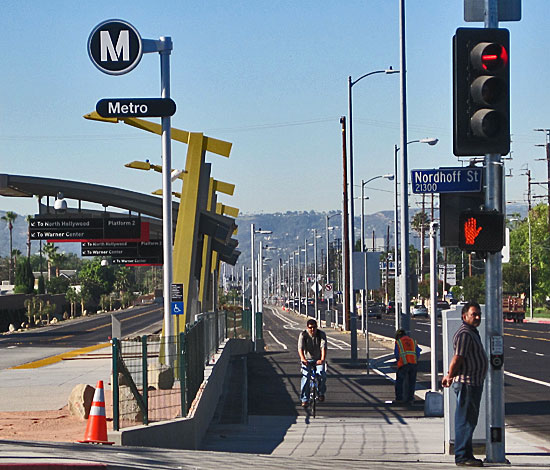
Even before it opens, the new Orange Line bike/pedestrian path is getting a workout. Photo/Dave Sotero, Metro
Bus passengers aren’t the only ones getting a slick new ride with this weekend’s opening of the Orange Line Extension.
The rapid transit busway features a dedicated bicycle/pedestrian path that’s being billed as the longest “transit-adjacent” bikeway of its kind in Los Angeles County. The path runs next to the new 4-mile northward extension of the Orange Line, which opens to the public this weekend with free bus rides on Saturday and Sunday, and connects with the original line’s 14-mile bikeway for a total of 18 miles. (By comparison, the newly-opened Expo Line bikeway is 6 miles long; it will grow to 16 miles when the line is completed to Santa Monica.)
Even before the ribbon is cut on the Orange Line Extension—which extends the popular busway northward from Warner Center to Chatsworth—cyclists and walkers have been giving the new path a workout. One project official counted 257 bicyclists and pedestrians out enjoying the new 4-mile stretch on a recent evening.
“I use it every day,” said Manny Samuel. “It’s safer for me [than the street] with all these cars.”
For Samuel, the bikeway even makes possible an old-fashioned midday break that most modern-day Angelenos can only dream of. “I’m going home for lunch,” said Samuel, who works at a nutrition research company, as he prepared to pedal from Canoga Park to Woodland Hills.
Dan Flores, out walking on a recent sunny day, said he’s already hitting the path for an average of six or seven miles a day—on foot or on bike. It’s great exercise—and a nice way to beat high gas prices. “I have a big giant truck that costs me $10 just to turn it on,” he said.
For teenagers like Anthony Winn and Gianni Darienzo, the new bike path has emerged as the preferred route to that time-honored summer destination: the mall. Compared to getting a lift in the car, “riding a bike’s better,” Darienzo said, as he and Winn returned from a trip to the Westfield Topanga Shopping Mall.
Most of the wide, asphalt-surfaced path has separate, dedicated lanes for bicyclists and pedestrians. Still, there are some “multiuse” areas in which walkers and cyclists will share space. Wider-than-usual 6-foot curb ramps also will allow cyclists and pedestrians to get on and off the path more easily, especially when it’s crowded.
Landscaping remains nonexistent along much of the path, but several hundred trees, such as incense cedars and Chinese flame trees, are set to go in soon, along with drought-tolerant plants including trailing rosemary and fortnight lilies.
The overall bus project is coming in ahead of schedule and under budget by $61.6 million, having used just $154 million of the $215.6 allocated. The acceleration was made possible, in large part, by the passage of Measure R by county voters in 2008, said project manager Hitesh Patel. Patel said the bicycle/pedestrian path is only part of a host of healthy and environmentally friendly elements incorporated into the new busway, which also has some solar-powered lighting panels, bioswales to naturally filter runoff water and even recycled construction debris from the 405 Project, which has been crushed and used as an underground base.
Those who want to ride the new busway extension can do so for free on Saturday, June 30, and Sunday, July 1. (The free rides are being offered only on the extension portion of the Orange Line running from Canoga Park to Chatsworth.) There also will be family-friendly festivities from 10 a.m. to 4 p.m. on Saturday at the Canoga Park and Chatsworth stations.
Those include a group ride with Valley Bikery, which sets out from the Canoga station at 1 p.m. and finishes at the Chatsworth station.
Nathan Baird, bicycle coordinator for the Los Angeles Department of Transportation, said he expects to see cyclists using the bike path—and the Orange Line itself—in a variety of ways.
“Having the bike path right next to the transit gives you a whole slew of options,” he said.
And the sheer 18-mile length of the path is a major plus, he said.
“The miles are important,” Baird said. “It connects across the entire Valley.”
Those connections eventually will go even further.
In the not too distant future, he said, cyclists will be able to start on the Browns Creek bike path in Chatsworth, connect with the Orange Line bikeway, travel along dedicated bike lanes through stretches of Los Angeles and Burbank and end up on the L.A. River bike path, which in turn will open up new connections stretching all the way to Long Beach.
As Patel, the project manager, puts it: “It’s going to be a wonderful asset for the San Fernando Valley…and for bicyclists, runners and nature lovers across the county.”
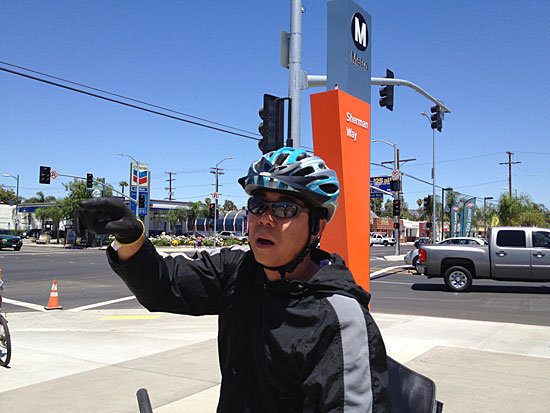
Manny Samuel, who lives in Woodland Hills and works in Canoga Park, uses the bikeway to ride home for lunch.
Posted 6/27/12
Do beach report cards make the grade?
June 14, 2012
Summer is almost here, with news from the coastline: More than 80% of the county’s beaches are clean.
Or are they?
Beach report cards such as those generated by Heal the Bay and Los Angeles County raise public consciousness and spur crucial cleanup efforts. But what do they really mean?
Chad Nelsen, environmental director of the San Clemente-based Surfrider Foundation, says he views beach grades and report cards as a rough-but-useful guide to a beach’s overall cleanliness and history. Beach grades aren’t same-day evaluations, he notes, and they don’t yet say enough about why a beach’s bacteria level may be elevated.
“Any given beach can be clean on any given day, but these kinds of report cards look at the average,” says Nelsen. “They can tell you if a beach is chronically polluted or typically clean.”
Beach grades are culled from ocean water samples collected from hundreds of coastal locations. In Los Angeles County, the Department of Public Health samples the water weekly at 40 sites between the Ventura County line and the Redondo Beach Pier, plus five sites between April and October at Avalon Beach on Catalina Island.
In addition, the department reviews monitoring results from scores of samples taken by the Los Angeles Bureau of Sanitation, the Hyperion water treatment plant and the Los Angeles County Sanitation District.
Those samples are tested for total coliform, fecal coliform, and enterococcus bacteria—so-called “indicator” bacteria that signal the presence of agents that can make swimmers sick. The results are compared to state water quality standards and updated each week by the Department of Public Health. Then they are turned into a rolling 30-day online “report card” that grades the water quality at each beach from A to F.
The test results also are shared with Heal the Bay, a nonprofit environmental watchdog group that analyzes water quality at hundreds of beaches along the West Coast and posts its own weekly beach-by-beach assessment, as well as a comprehensive annual report published in May.
Surfrider’s Nelsen compares beach grades to “a spelling class, with a bunch of weekly quizzes.”
“You might get an A or a B or even an F on a given week, but if the scores average out to an A at the end of the month or the end of the year, you’re probably doing pretty well.”
This year’s Heal the Bay report had mixed reviews for L.A. County: Some 82% of the county’s beaches had earned dry-weather grades of A or B last year, a 7-point improvement over the prior year. But the county was still below the statewide average, and trouble spots persisted in places like Avalon and Malibu.
The reasons for those scores tend to defy simplification.
Ken Murray, who directs the Department of Public Health’s Bureau of Environmental Protection, says the test results, and therefore the grades, are impacted by all sorts of factors—weather, water depth, whether the sample was taken near or far from the mouth of a storm drain, even the number of birds in the area.
Pollution control efforts inland can make a big difference. Malibu’s new Legacy Park, for example, is essentially a grassy, state-of-the-art system for capturing urban runoff. And Murray says a new rainwater harvesting system at Penmar Park in Venice “is really going to help the water quality in the beaches because runoff there is going to be captured and treated—and used to water the Penmar Park golf course—before it can hit the bay.”
Precipitation is also a major factor. A beach that is Grade A in dry weather can be rendered unfit overnight by a heavy rain and the ensuing runoff, and be perfectly swimmable again in less than a week as bad bacteria are dispersed by waves and killed by sunshine.
Long Beach, for instance, was a coastal success story this year, partly because of big projects upstream that diverted runoff, upgraded sewers and reduced the tons of debris that the Los Angeles River dumps out onto its beaches. But city officials noted that part of that sharp improvement—93 percent of the city’s beaches recorded A or B grades on the Heal the Bay scorecard—may also have simply stemmed from a relative lack of rain.
Avalon, meanwhile, has been a chronic low scorer and officials have spent years trying to pin down the reasons. “We had thought the problem was sewage lines around Avalon Harbor,” Murray says. “But they spent millions to repair that, and the bacteria levels are still high.”
More tests—these ones on boats—were similarly inconclusive. Now Avalon’s antiquated sewers are undergoing a new, multi-million-dollar round of repairs, and the city is under a cease-and-desist order from the state to clean up its water. Also, Murray says, a team of UC Irvine researchers is studying Avalon “to give us a new set of eyes.”
Amanda Griesbach, a Heal the Bay water quality scientist, says the science is evolving. Someday, she predicts, beachgoers will be able to tell the cleanliness of the water with a single, same-day dipstick test that will be posted at each beach and may even suggest a pollutant’s origin.
“When that happens—and that’s where the science is heading—it will be awesome,” says Griesbach. “But right now, the existing methods are the best we have.”
Posted 6/14/12
A park’s legacy grows in Malibu
February 27, 2012
Legacy Park in Malibu has wildlife, sculptures, outdoor classrooms and five coastal habitats. But to understand why Los Angeles County’s most innovative new recreational area recently racked up its sixth award in 16 months of existence, you have to look deeper—underground, in fact.
Beneath its meandering walkways and drought-tolerant plantings, the 15-acre central park at Cross Creek Road and Pacific Coast Highway is actually a state-of-the-art system for capturing and cleaning urban runoff that would otherwise course to the ocean, carrying bacteria and trash.
Hidden pipes and filters, working in tandem with the park’s landscaping and Malibu’s existing storm water treatment facility, have trapped and decontaminated tens of millions of gallons of toxic storm water since the park opened in October, 2010.
“It’s pretty unique,” says Malibu City Manager Jim Thorsen, noting that the park was just named the American Society of Civil Engineers’ 2011 Project of the Year for California—the latest in a long string of accolades.
“I don’t know of any other places that not only capture and treat their storm water, but then build a park around it and make it possible for visitors to come in and learn.”
The park grew out of longstanding concerns about bacterial contamination from runoff at Malibu Creek, Malibu Lagoon and Surfrider Beach. When winter storms strike in Southern California, the rains carry chemicals and debris into the Santa Monica Bay from as far away as Thousand Oaks and the Santa Monica Mountains, poisoning the ocean and polluting the beach.
Under pressure to comply with clean water mandates, the city bought a vacant lot and—with $13 million in funding amassed from private and public donors, including $700,000 in Proposition A park funds—began turning the dusty tract into what Thorsen has dubbed “an environmental cleaning machine.”
Runoff from some 337 surrounding acres flows into the park via three major storm drains, then is filtered through a system of screens to catch plastic bags, paper cups and other litter. Then the water runs through more filters to a 2.6 million gallon retention pond at the park’s center, where it sits while contaminants settle at the bottom of a natural sedimentation basin.
Finally, the water is piped to the other side of Civic Center Way, where the city’s storm water treatment facility can clean and disinfect it with ozone. Then the cleaned water is used to irrigate the park, or, on rare occasions, is discharged back into Malibu Creek.
“What has really surprised us is how well it has functioned,” says Thorsen. “We’ve seen water go in, the pond fill, the pumps and the system work to perfection, and the water recycle back into the park. It has worked out exactly as it was supposed to work.”
Kathy Haynes, who chaired the ASCE awards committee, calls the park “an innovative example of incorporating sustainability, showing environmental responsibility and using forward thinking.”
For Thorsen, however, the reward is in the number of calls he’s been getting from developers and communities interested in similar projects, and in the public response over the past year as Legacy Park has come to life.
“It looked like a barren desert, when we first planted it,” he says, “but everyone—the people, the birds, the animals—seems to love it. I’m amazed at how much things have grown in just one year.”
Posted 2/6/12
Want to be part of the solution? Some expert tips on how you can avoid contributing to urban runoff are here.
Streaming live from the Valley
February 15, 2012
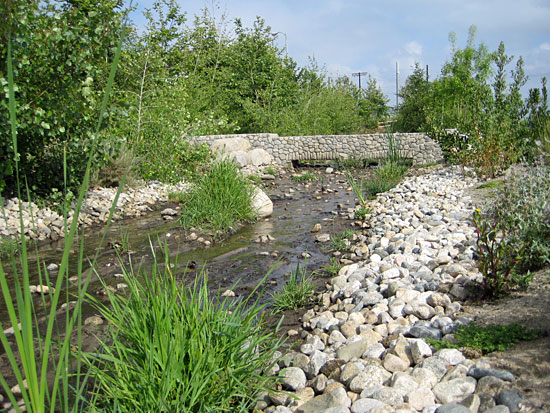
Phase I of the Tujunga Wash Ecosystem Restoration Project has already grown lush. Phase II is underway.
The San Fernando Valley is about to get a little greener. Phase II of the Tujunga Wash Ecosystem Restoration project breaks ground next Wednesday. By the time it’s completed, it will have restored ten acres of open space and created a sustainable stream system in the neighborhood of Valley Glen.
The $7 million project is a joint effort by the Los Angeles County Department of Public Works and the United States Army Corps of Engineers. The area to be restored is 3,000 feet long and 65 feet wide on each side of the wash. The finished section will link two existing “greenbelts”—Phase I of the project and an “original” greenway from the 1970s, forming 13,200 consecutive feet of revitalized land.
For the ecosystem, the project means nesting for migratory birds and a corridor for wildlife movement. Native vegetation will be installed, and the new stream will give local plants a chance to take root. The stream will replenish groundwater and act as a natural filter to urban runoff.
“The goal is to mimic Tujunga Wash in its natural state, but on a smaller scale,” said Richard Gomez, project manager for Department of Public Works.
For humans, the project offers a place to walk, learn and explore. Ornamental gates will mark entry points, a 12-foot-wide path will give pedestrians and bicycles room to meander and educational signage will teach visitors about the local ecosystem and the project itself. Benches and rock wall seating will offer folks a place to rest amid the greenery. Existing chain-link fencing will be replaced with more aesthetically pleasing material.
A ceremonial groundbreaking will take place at 10 a.m. on Wednesday, February 22, at the intersection of Vanowen Street and Fulton Avenue. Speakers include Supervisor Zev Yaroslavsky, Colonel R. Mark Toy and Public Works Director Gail Farber. The public is invited to attend.
The Tujunga Wash feeds into the Los Angeles River in Studio City. In the first half of the 20th century, repeated flooding of the channel caused widespread property damage and even some deaths. As a result, in the 1950s the Army Corps of Engineers lined nine miles of it with concrete. This and other human activity had the unintended effect of eliminating the natural habitat of the waterway.
The longterm hope is revitalization of the entire length of the Tujunga Wash, said Gomez. When the current project is completed this fall, that goal will be 3,000 feet closer.
Posted 2/15/12




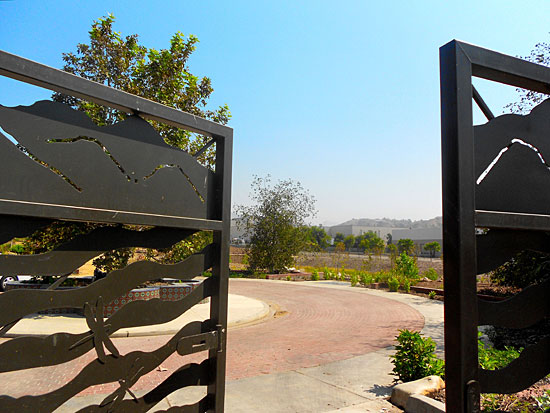
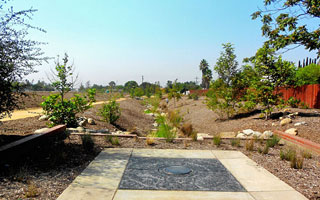
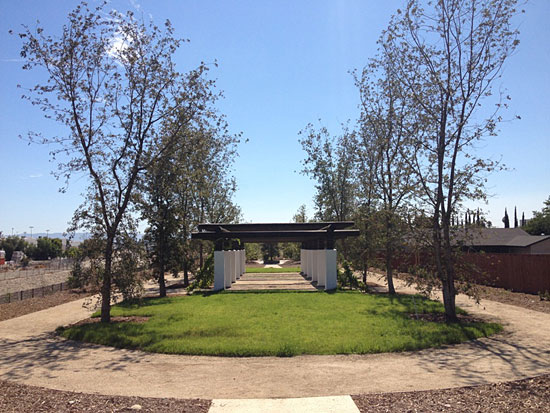
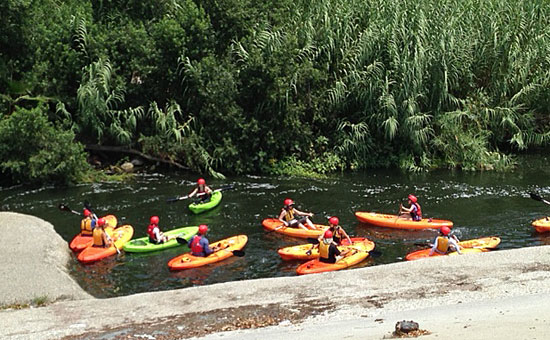
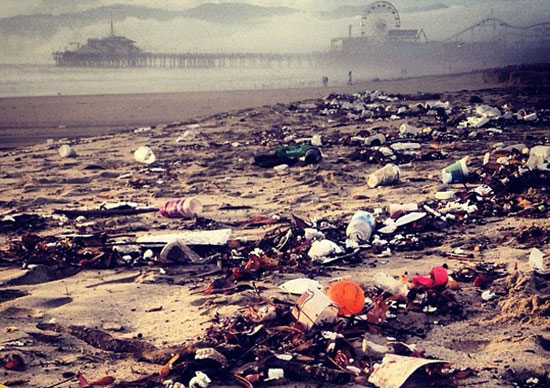
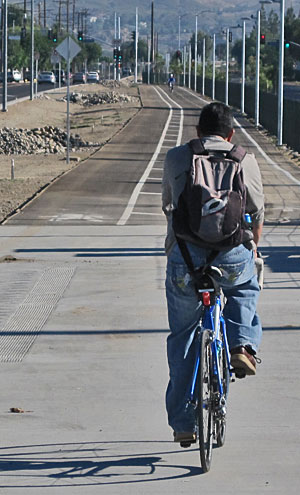
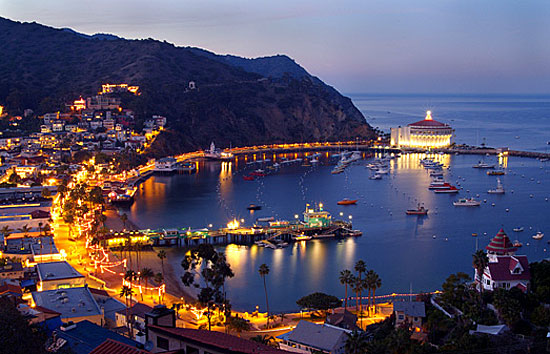
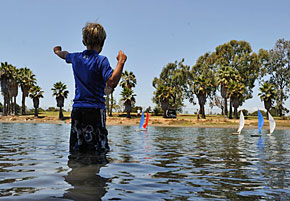
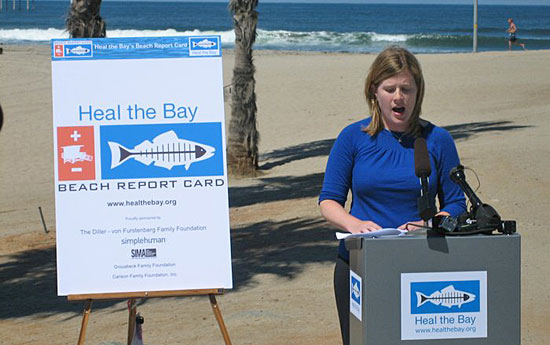
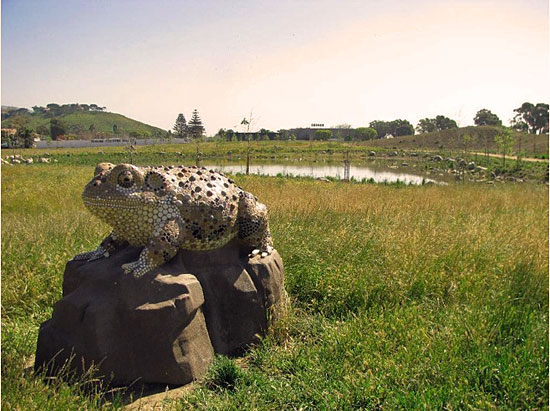
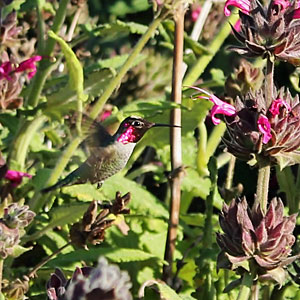
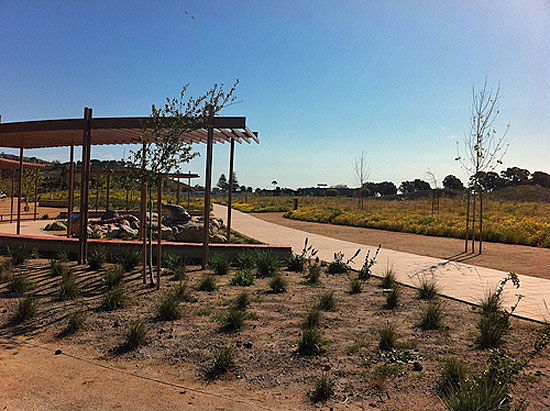







 405 bridge work causes a stink
405 bridge work causes a stink

